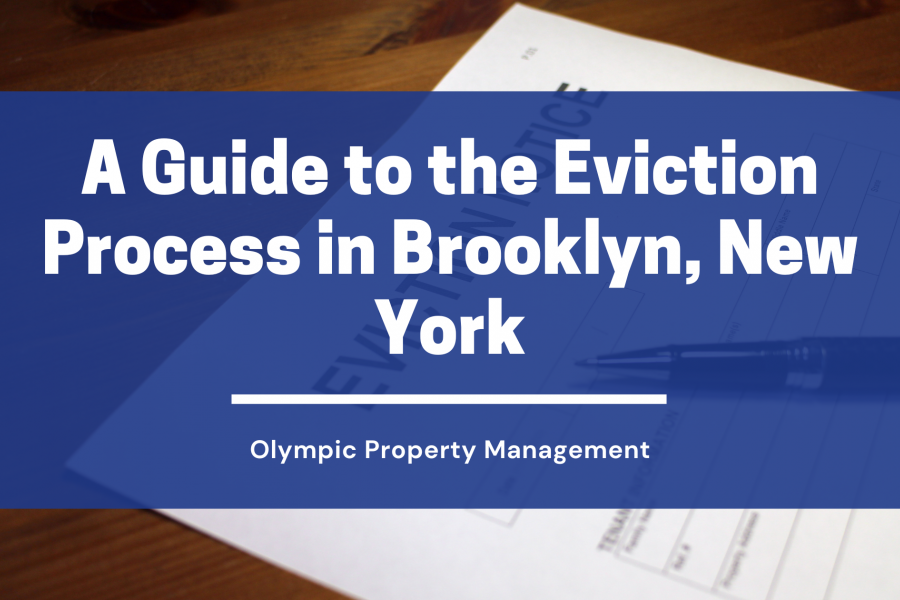
.png)
As a New York landlord, you have a right under landlord-tenant law to evict a tenant. You must have legal ground, however. Examples of legal grounds for eviction include nonpayment of rent and violation of the lease agreement.
Landlords can expect the entire eviction proceedings to take between one and five months.
It goes without saying that the landlord must not try to evict a tenant on your own. For instance, by removing their belongings, shutting down their utilities, or locking them out. The only way to evict a tenant in New York is through a court order.
And even after obtaining a court order in New York, a landlord must seek the help of a sheriff, marshal, or constable to physically evict the tenant.
What Is New York’s Eviction Process?
To begin the eviction process, a landlord must have legal grounds. You cannot begin the process for any illegitimate reason.
Next, a landlord must terminate the tenancy by serving the tenant with a written notice. Usually, a proper notice of eviction gives tenants two options: to fix the violation or simply to move out. If the matter is unresolved, you have the option of filing a lawsuit in court.
If the judgment is in your favor, the landlord will be issued with a Warrant of Eviction and the tenant will have to move out.

Notice for Lease Termination With Legal Cause
As previously mentioned, a landlord can evict a tenant for a number of reasons. Next, you must serve the appropriate termination notice.
The type of eviction notice to serve depends on the violation the tenant has committed. In New York, the eviction notices are as follows.
- 14-Day Notice to Pay Rent or Quit. If your tenant is late on paying rent, you can commence the eviction process by serving them this notice. The notice will give the tenant 14 days to pay the rent due or leave.
- 30-Day Notice to Quit. You can also end the tenancy of a tenant who overstays their rental agreement or doesn’t have a lease agreement, to begin with. The notice gives the tenant 30 days to move out of the rental unit. There is no other option the tenant has other than to move out.
- For tenants that don’t pay on a monthly basis, the eviction notice to serve will depend on the rent payment frequency. For tenancies of less than a year, you must give them a 30 days notice. For tenancies exceeding a year, but less than 2 years, you must give them a maximum of 60 days. For tenancies exceeding a year, you must serve them a 90 days notice.

Serving a Tenant with an Eviction Notice in New York
Landlords must serve an eviction notice to a tenant as the law dictates. In New York, landlords must do it in one of the following ways.
- In person.
- Posting a copy on the front door.
- Mailing a copy via registered or certified mail. If you are leaving a copy with another person other than the tenant, you must also send a copy to the tenant via regular mail.
Tenant Eviction Defenses in New York
If the tenant doesn’t fix the violation or move out, you can now take the matter to court. You must file a petition in the appropriate district court. After a successful filing, the court will issue you with a copy of the notice of petition and petition for eviction.
The tenant will also need to be served with a copy. The person serving the tenant must be at least 18 years old and not part of the ongoing case. Also, this must be done 10-17 days before the day of the hearing.

The following are some of the defenses the tenant may give to stop or delay their eviction.
- The eviction notice contained substantial errors. Such as missing the effective day of eviction.
- The tenant fixed the violation. For instance, paid the rent due within the notice period.
- The tenant didn’t commit the violation as alleged.
- The eviction was in retaliation to the tenant exercising a legal right.
- The eviction was based on a protected class.
Attending Court Hearing
As already mentioned, the hearing will be held between 10-17 days after the petition is served on the tenant. Either party has a right to request an adjournment of 14 days.
If the court rules in your favor or the tenant fails to attend the hearing, you’ll be issued with a Warrant of Eviction.
Warrant of Eviction
This is the tenant’s final notice to leave. The notice will give the tenant a chance to remove their belongings or else risk getting forcefully evicted from the property.
The tenant has a maximum of 14 days to move out of the rental unit on their own after receiving a Warrant of Eviction. However, if the eviction is for nonpayment of rent, then the tenant will only have 10 days to leave.
Bottom Line
There may come a time when you need to preform a new york eviction. And it’ll be important that you follow the right process to be successful and avoid potential legal issues with your tenant.
If you have specific questions or need help with managing your property, Olympic Property Management can help. We’re a full-service property management company that can help you manage your rental property reliably and professionally.
We can help you market your property, screen prospective tenants, collect rent payments, and more! Get in touch to learn more about our services!
Disclaimer: This blog should not be used as a substitute for legal advice from a licensed attorney in your state. Laws change, and this post might not be updated at the time of your reading. Please contact us for any questions you have in regards to this content or any other aspect of your property management needs.